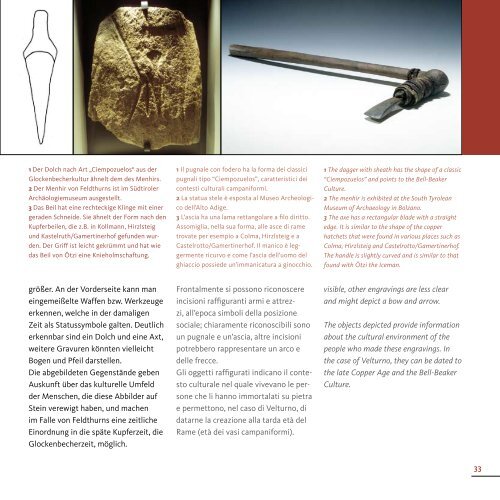Un regno di pietre. - Rete Civica dell'Alto Adige
Un regno di pietre. - Rete Civica dell'Alto Adige
Un regno di pietre. - Rete Civica dell'Alto Adige
You also want an ePaper? Increase the reach of your titles
YUMPU automatically turns print PDFs into web optimized ePapers that Google loves.
1 Der Dolch nach Art „Ciempozuelos“ aus der<br />
Glockenbecherkultur ähnelt dem des Menhirs.<br />
2 Der Menhir von Feldthurns ist im Südtiroler<br />
Archäologiemuseum ausgestellt.<br />
3 Das Beil hat eine rechteckige Klinge mit einer<br />
geraden Schneide. Sie ähnelt der Form nach den<br />
Kupferbeilen, <strong>di</strong>e z.B. in Kollmann, Hirzlsteig<br />
und Kastelruth/Gamertinerhof gefunden wurden.<br />
Der Griff ist leicht gekrümmt und hat wie<br />
das Beil von Ötzi eine Knieholmschaftung.<br />
größer. An der Vorderseite kann man<br />
eingemeißelte Waffen bzw. Werkzeuge<br />
erkennen, welche in der damaligen<br />
Zeit als Statussymbole galten. Deutlich<br />
erkennbar sind ein Dolch und eine Axt,<br />
weitere Gravuren könnten vielleicht<br />
Bogen und Pfeil darstellen.<br />
Die abgebildeten Gegenstände geben<br />
Auskunft über das kulturelle Umfeld<br />
der Menschen, <strong>di</strong>e <strong>di</strong>ese Abbilder auf<br />
Stein verewigt haben, und machen<br />
im Falle von Feldthurns eine zeitliche<br />
Einordnung in <strong>di</strong>e späte Kupferzeit, <strong>di</strong>e<br />
Glockenbecherzeit, möglich.<br />
1 Il pugnale con fodero ha la forma dei classici<br />
pugnali tipo “Ciempozuelos”, caratteristici dei<br />
contesti culturali campaniformi.<br />
2 La statua stele è esposta al Museo Archeologico<br />
dell’Alto A<strong>di</strong>ge.<br />
3 L’ascia ha una lama rettangolare a filo <strong>di</strong>ritto.<br />
Assomiglia, nella sua forma, alle asce <strong>di</strong> rame<br />
trovate per esempio a Colma, Hirzlsteig e a<br />
Castelrotto/Gamertinerhof. Il manico è leggermente<br />
ricurvo e come l’ascia dell’uomo del<br />
ghiaccio possiede un’immanicatura a ginocchio.<br />
Frontalmente si possono riconoscere<br />
incisioni raffiguranti armi e attrezzi,<br />
all’epoca simboli della posizione<br />
sociale; chiaramente riconoscibili sono<br />
un pugnale e un’ascia, altre incisioni<br />
potrebbero rappresentare un arco e<br />
delle frecce.<br />
Gli oggetti raffigurati in<strong>di</strong>cano il contesto<br />
culturale nel quale vivevano le persone<br />
che li hanno immortalati su pietra<br />
e permettono, nel caso <strong>di</strong> Velturno, <strong>di</strong><br />
datarne la creazione alla tarda età del<br />
Rame (età dei vasi campaniformi).<br />
1 The dagger with sheath has the shape of a classic<br />
“Ciempozuelos” and points to the Bell-Beaker<br />
Culture.<br />
2 The menhir is exhibited at the South Tyrolean<br />
Museum of Archaeology in Bolzano.<br />
3 The axe has a rectangular blade with a straight<br />
edge. It is similar to the shape of the copper<br />
hatchets that were found in various places such as<br />
Colma, Hirzlsteig and Castelrotto/Gamertinerhof.<br />
The handle is slightly curved and is similar to that<br />
found with Ötzi the Iceman.<br />
visible, other engravings are less clear<br />
and might depict a bow and arrow.<br />
The objects depicted provide information<br />
about the cultural environment of the<br />
people who made these engravings. In<br />
the case of Velturno, they can be dated to<br />
the late Copper Age and the Bell-Beaker<br />
Culture.<br />
33



